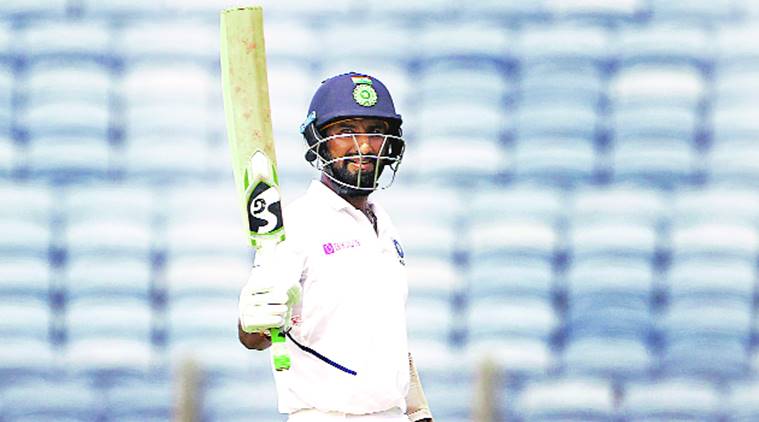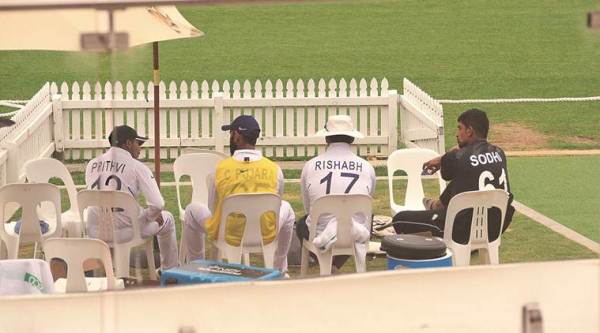Shared News| February 18, 2020 8:56:45 am
Cheteshwar Pujara scored 93 in the tour game against New Zealand XI in Hamilton. He aggregated 60 runs in the four innings in his previous tour to New Zealand. (Express Photo)
A month or so before the New Zealand tour, Cheteshwar Pujara randomly revisited the scorecards of his previous trip to the country. Not because he was nerdish or nostalgic, or as part of an elaborate pre-tour preparation, but just to get a hang of the impending challenge. “Just to trigger my memory, just to get into the mood. Not particularly how I was dismissed, but for a general recollection of the match,” Pujara told Media, before leaving for New Zealand.
Browsing the scorecards, the two Tests flickered through his mind. Sitting at his home in Rajkot, he could see right in front of his eyes how he got out in the each of the four innings. First Test, first innings in Auckland: “Loose shot, I just pushed at a wide ball,” he says. Second innings: “I was batting well, faced 70-80 balls and then got a good ball. Could have played it better.” Second Test, first innings in Wellington: “Got a start, then was lbw to an in-swinger.” Second innings: “I was caught down the leg-side off a bouncer.”
Just 60 runs off four innings, it’s where for the first time in his Test career criticism began to swirl around him. It was his first supposed failure at this level too. On his previous overseas trip, to South Africa, he had crunched a magnificent second-innings hundred in Johannesburg and was living up to the early hype and reputation. At that juncture of his career, he averaged around 60. “I have always felt that I could have done better in that series,” Pujara says.
But the next year, after disappointing tours to Australia and England, his career was at a crossroads. From his technique to scoring rate, every aspect of his batting was over-scrutinised. He didn’t brood over his failures — he had the support system too — but an uneasy angst clutched him. From it stemmed realisation.
“Until that point, I thought Test runs were Test runs. Wherever you score those runs, it’s the same. I was not obsessed with things like scoring a lot of runs overseas. I wanted to score everywhere, be it in India or overseas. The satisfaction always came not from the amount of runs I scored, but how it would benefit the team. But now I realised how difficult it is to score runs abroad, from an individual and team perspective. So I needed to work on my game, see what’s going on and correct the mistakes,” he says.

More than any amount of homework or practice sessions, Pujara comprehended the significance of warm-up games.
He was equally baffled by the phrase ‘tough conditions’. “It’s another misconception that only conditions in Australia, New Zealand, England and South Africa are difficult. True, we are more accustomed to subcontinental conditions, but some of my innings at home like the 90 in Bangalore against Australia, or the hundred I got in Sri Lanka were as satisfying as some of my hundreds in Australia,” he observes.
The latter innings of 145 not out — to which he keeps coming back — came on an SSC green-top with Dhammika Prasad producing insane movement. Moreover, Pujara was making a comeback and opening the innings. The 92 in Bangalore against Australia was on a tacky surface, India were a Test in deficit and Australia’s spin pair of Nathan Lyon and Steve O’Keefe was looking to scythe through the hosts’ batting line-up. Those were probably series-winning efforts too.
In that time, he also realised that preconceived notions could turn counter-productive. “If you are touring a country for the first time, you are bound to have certain preconceptions, that the pitches would behave this way or that way, that I will have to play in a particular manner. Sometimes, you watch videos of old games or talk to players who have played there. And this gets into your mind. These are all useful, but in the end, you have to assess your own game and find the best method that suits you. To go with an open but aware mind,” he says.
An open but aware mind — it’s an incredibly difficult space to be in. To keep changing your game on the move, but not overtly compromising with your technical game. Batting is a lot about instincts and second-guessing, taking hints from bowlers and out-thinking them, but it’s also about removing presuppositions. It’s a gamble but at the same time a study.

So Pujara, like most Indian batsmen, reached New Zealand prepared for devilishly swinging surfaces. That’s what old cricketers and older scorecards might have told him. But he realised that bounce could be another antagonist.
“As some of the pitches swing a lot, you discount the bounce. But most pitches have good bounce and they have bowlers who can make use of the bounce. So batsmen should be prepared for seam, swing and bounce. But after a point, it becomes nice to bat on. I remember Virat (Kohli) and Shikhar (Dhawan) scored hundreds (in 2014). A good ball can come at any time, but that’s true everywhere, even in the subcontinent. Maybe, it comes often. As a batsman, you have to be prepared for it whenever or wherever you’re playing,” he says.
More than any amount of homework or practice sessions, Pujara comprehended the significance of warm-up games. “They might field average bowlers, they might give surfaces dissimilar to the ones you get in the Test match, but the more time you spent in a country, the more acclimatised to the conditions you get. After all, the nature of the pitches can’t be too different, and at this level you know the quality of bowlers. Most of them you have played before, you’ve watched videos and there’s no unfamiliarity,” he observes. But the wind makes horizontal bat shots difficult.
So whenever there’s an opportunity, he tunes up for a series with as many warm-up games as possible, or county games like he did before the trip to England two years ago. He had a terrible time in the build-up to the series, but ended up enjoying a revival with a terrific hundred in Southampton.
For the ongoing tour, he landed early enough to get an India A game, where he scored 53 in Lincoln, and a warm-up game, where he scored 93 in seam-bowling-friendly conditions, laying out the blueprint to bat in New Zealand.
If Pujara can’t get enough game time in the country he’s going to play, he ensures he plays a lot of first-class cricket. Like in the lead-up to the Australia series, or in the prelude to the New Zealand tour, he got to play five Ranji Trophy games.
“I never like to miss Ranji games, for you always learn something or the other each season. After all these international games, I feel Ranji still teaches you lot. It also gives me the freedom to experiment on a few different aspects of my game, which I can’t in international cricket. Besides, I like playing at small venues. It’s like going back to your younger days,” he says.
The late start to the season benefitted him too, as some of the tracks he encountered offered swing and seam movement, like in Saurashtra’s Ranji opener against Himachal Pradesh at Dharamshala. He made just 2 and 14, faced just 33 deliveries, but the match shook off him rustiness.
“It was quite cold and breezy, and there was a bit of lateral movement. Though it’s different to New Zealand, it sort of helps you get into that mental groove. And I had a lot of time at the nets, working on a few aspects of my batting,” he says. It’s true that Pujara gets more time to play first-class games than some other cross-format regulars, but his drive to rack up as many first-class matches and runs as possible is gluttonous.
***
From the Sydney Test early last year, where Pujara piled 193 to the 248 he compiled against Karnataka in his penultimate Ranji Trophy game last season, he went through an uncharacteristic phase where it was difficult to assess whether he was going through a genuine rough patch or just getting out. Sometimes, he got out to a good ball; sometimes, he made the wicket balls look great, like a couple of dismissals in West Indies, sometimes he looked fluent, sometimes he seemed rickety. There were times he played atypical shots to get out. It was a bizarre phase — wherein he eked out only 314 runs in 10 outings. For someone who converts at least one of his two fifties into a century, he scored four half-centuries without upgrading any into a three-digit score.
One of the glitches was getting squared up by balls that angled in and held the line a bit, like how Kemar Roach nailed him in the first innings at North Sound.
Perhaps, this was playing on his mind, he tried to get in the line of a similar delivery in the second innings, but on this occasion, the ball seamed back in and burst through his defence. But he seemed to have rectified the defect, for in the warm-up game in Hamilton, he was comfortably fending off similar deliveries. Similarly Vernon Philander in Visakhapatnam, where the ball that seamed away after landing accounted for him in the first innings. In Pune, he hung his bat outside the off-stump to a Kagiso Rabada back-of-length ball that delicately nibbled away. The diffidence outside the off-stump made him vulnerable to nip-backers too. Then came a phase, wherein he would get starts and bat smoothly before a lapse in concentration cost him his wicket.
Consequently, the runs and centuries dried up, to an extent that there were whispers of worry. But at no point was Pujara concerned. “I agree there were a few technical issues, but nothing major. Just about correcting a few things, which happens to every batsman, which I did. Otherwise, I felt I was batting fluently. Of course you can’t score a hundred every time you go out to bat in an international match, though you want to. Just like a bowler can’t pick a five-for every time he’s out there,” he says.

New Zealand spinner Ish Sodhi sits alongside the Indian trio of Prithvi Shaw, Cheteshwar Pujara and Rishabh Pant during the tour game. (Express)
But he never had to wait this long for a hundred. A daddy-hundred machine that he’s at all levels, the wait might have been agonising, especially as he was nearing his 50th first-class hundred. “I am not a milestone man. It has never been my motivation. I’d rather cherish my journey to the 50th than think of the 50th,” he says in his typically self-effacing manner.
The 50th century aptly came against Karnataka, against whom Pujara averages a shade under 100, and typically he converted the century into 248. “Before a big tour, getting a double hundred against a quality bowling side was heartening. It was never a burden to me, but it gives a lot of satisfaction that the adjustments I made are working out and I could take this confidence to New Zealand. It’s about getting into that clear mental state, where you know what you should do and what you should not,” he states. And the 93 in the warm-up game reflected more that anything else the inner peace.
***
Between the two New Zealand tours, six years separating them, life has come a full circle for Pujara. From getting dropped to bouncing back to getting dropped again and bouncing back again, from being criticised for his lack of runs abroad to fashioning India’s maiden series triumph in Australia, from being blamed for his slow batting to getting appreciated for reviving the fading art of stonewalling, Pujara’s time has been more eventful than he projects it. If he was a slightly apprehensive batsman, suffocated by the Rahul Dravid successor tag, back then, he’s an accomplished heir to the India great. And a father.
Typically, Pujara self-effaces. He pauses, as if he’s recollecting the journey and says: “Obviously, I have grown both as a person and batsman. I am a more balanced character, better prepared to deal with failures, more level-headed in taking success. But while the past satisfies you, you need to look ahead too. All I am thinking about now is getting runs in New Zealand,” he says.
He’s slowly ticking the boxes: Hundreds in South Africa, England, Australia, and now beckons New Zealand. Hopefully, when he flips through the scorecards of this series a few years later, he could smile and not be seized by an “I could have done better” gasp. And he would stride into the middle with an open but aware mind.




